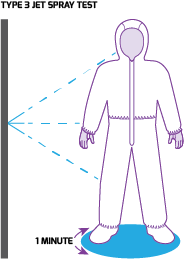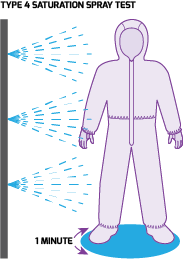Prüfungen Des "Gesamten Overalls" Übersicht Und Beschreibung
| Typ | Standard & Testmethode | Testbeschreibung | |
|---|---|---|---|
| Typ 3 Spritzstrahltest |
EN 14605+A1 :2009
|
 |
Der ganze Overall wird einer Reihe von kurzen, direkten Strahlen einer wasserbasierten Flüssigkeit (mit geringer Oberflächenspannung von 30-35 m N/m) ausgesetzt. Die Strahl- düsen sind in 1 m Entfernung vom Overall platziert und der Abgabedruck beträgt 3 bar. Die Flüssigkeit ist gefärbt, so dass eine Leckage die Unterkleidung sichtbar verfärbt. Die Prüfung gilt als bestanden, wenn die gesamte verfärbte Fläche auf der Unterklei- dung kleiner als das Dreifache des Kalibrierflecks ist. (Der Kalibrierfleck ist die Fleckenfläche, die durch 0,02 ml der Prüfflüssigkeit entsteht.) |
| Typ 4 Sättigungs- Sprühtest |
EN 14605+A1 :2009
|
 |
Bei dieser Prüfung wird der ganze Overall einem Sprühnebel aus einer wasserbasierten Flüssigkeit (mit einer geringen Oberflächenspannung von 30-35 m N/m) ausgesetzt. Eine Gesamtmenge von 4,5 L wird für 1 Minute als feiner Nebel versprüht. Eine direkte Bestrahlung des Overalls erfolgt nicht. Während des Sprühens führt die Testperson ein definiertes, sanftes Bewegungsprogramm aus und dreht sich dabei. Die Flüssigkeit ist gefärbt, so dass eine Leckage die Unterkleidung sichtbar verfärbt. Die Prüfung gilt als bestanden, wenn die gesamte verfärbte Fläche auf der Unterklei- dung kleiner als das Dreifache des Kalibrierflecks ist. (Der Kalibrierfleck ist die Fleckenfläche, die durch 0,02 ml der Prüfflüssigkeit entsteht.) |
| Typ 5 Leckage von Partikeln Nach innen |
EN ISO13982-1:2004+A1:2010
|
Bei dieser Prüfung wird ein ganzer Overall (10 Prüfanzüge) einem trockenen Natriumchlorid-Aerosol (Partikelgröße = 0,6 μm) ausgesetzt. Währenddessen führt die Testperson folgende Sequenz von 3 Bewegungen durch: 9 Minuten stehen, 9 Minuten gehen, 9 Minuten hocken. Die Gesamt-Eintrittsleckage wird als Prozentsatz der Natrium- chloridkonzentration außerhalb des Anzuges ausgedrückt. Jede Anzug wird an 3 Punkten - Knie, Taille und Brust - gemessen. Für jeden Overall werden somit 9 Messungen ausgeführt. Eine Prüfung gilt als bestanden, wenn die Eintrittsleckage bei 82 von 90 Messungen weniger als 30 % beträgt. (Ljmn, 82/90 ≤ 30 %). Außerdem muss die durchschnittliche Eintrittsleckage (aus allen Bewegungen und Messpositionen) bei 8 von 10 Overalls weniger als 15 % betragen. (Ls, 8/10 ≤ 15%). |
|
|
Typ 6 |
EN 13034 :2005+A1 :2009
|
 |
Diese entspricht der Typ 4 - Prüfung, jedoch ist die vernebelte Flüssig- keitsmenge auf 1,9 L reduziert und die Oberflächenspannung auf 57 m N/m erhöht. Die Prüfung gilt als bestanden, wenn die gesamte verfärbte Fläche auf der Unterkleidung kleiner als das Dreifache des Kalibrierflecks ist. (Der Kalibrierfleck ist die Fleckenfläche, die durch 0,02 ml der Prüfflüssigkeit entsteht.) |
| Type | Standard & Test Method | Test Description | |
|---|---|---|---|
| Type 3 Jet Spray Test |
EN 14605+A1 :2009
|
 |
This test involves exposing a whole suit to a series of short jets of a water based liquid (with a low surface tension of 30-35 m N/m) aimed at various critical parts of the suit. The pressure of the jet when leaving the firing nozzle is 3 bar and the firing nozzle is situated at a distance of 1m away from the garment. The liquid is coloured, so that any inward leakage will visibly stain the undergarment. A suit has passed the test when the total stained area on the undergarment is smaller than three times the calibration stain. (The calibration stain is the stain area produced by 0.02 ml of the test liquid.) |
| Type 4 Saturation Spray Test |
EN 14605+A1 :2009
|
 |
This test involves exposing a whole suit to an intense spray of a water based liquid (with a low surface tension of 30-35 m N/m). A total quantity of 4.5 litres is sprayed as a fine mist for one minute. There is no pressure exerted by the fine spray on the suit. While being sprayed, the wearer of the suit will perform gentle movements while rotating. The liquid is coloured, so that any inward leakage will visibly stain the undergarment. A suit has passed the test when the total stained area on the undergarment is smaller than three times the calibration stain. (The calibration stain is the stain area produced by 0.02 ml of the test liquid.) |
| Type 5 Particle Inward Leakage |
EN ISO13982-1:2004+A1:2010
|
This test involves exposing a whole suit (10 test suits) to a dry aerosol of sodium chloride. The particle size is 0.6 μm. While being exposed to the dry aerosol, the wearer of the suit performs the following sequence of 3 movements: 9 minutes standing, 9 minutes walking, 9 minutes squatting. The total inward leakage is expressed as a percentage of the concentration of sodium chloride outside the suit measured for each test suit at 3 points – knee, waist and chest. Therefor, for each suit 9 measurements are taken. In order to pass the test the inward leakage must be less than 30%, for 82 of 90 of the measurements. (Ljmn, 82/90 ≤ 30%). And the average inward leakage (all movements and measurement positions for each suit – 9 readings) must be less than 15% for 8 of the 10 suits. (Ls, 8/10 ≤ 15%). |
|
|
Type 6 |
EN 13034 :2005+A1 :2009
|
 |
This test is essentially the same as the Type 4 spray test however the liquid in the Type 6 test has a slightly higher surface tension of 57 m N/m and the quantity sprayed is reduced to 1.9 litres. A suit passes the test when the total stained area on the undergarment is smaller than three times the calibration stain. (The calibration stain is the stain area produced by 0.02 ml of the test liquid.) |

